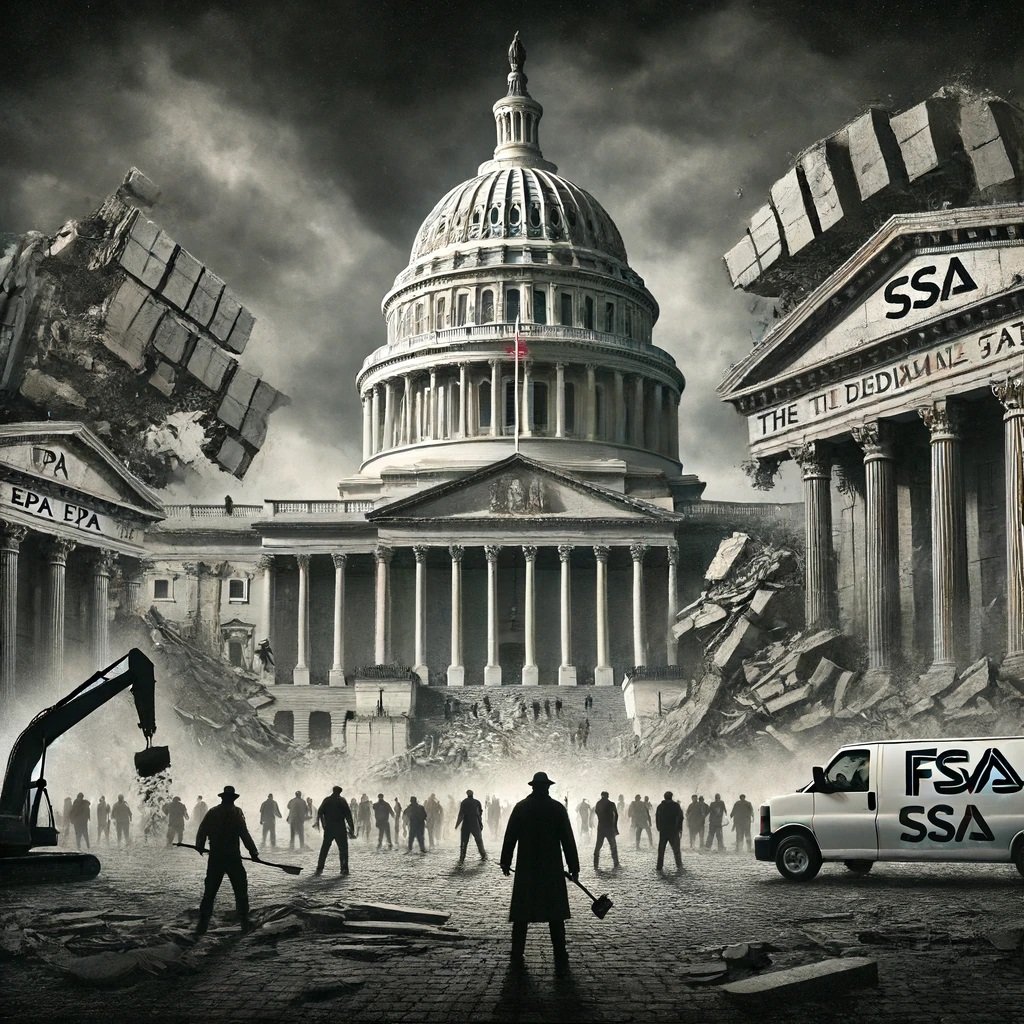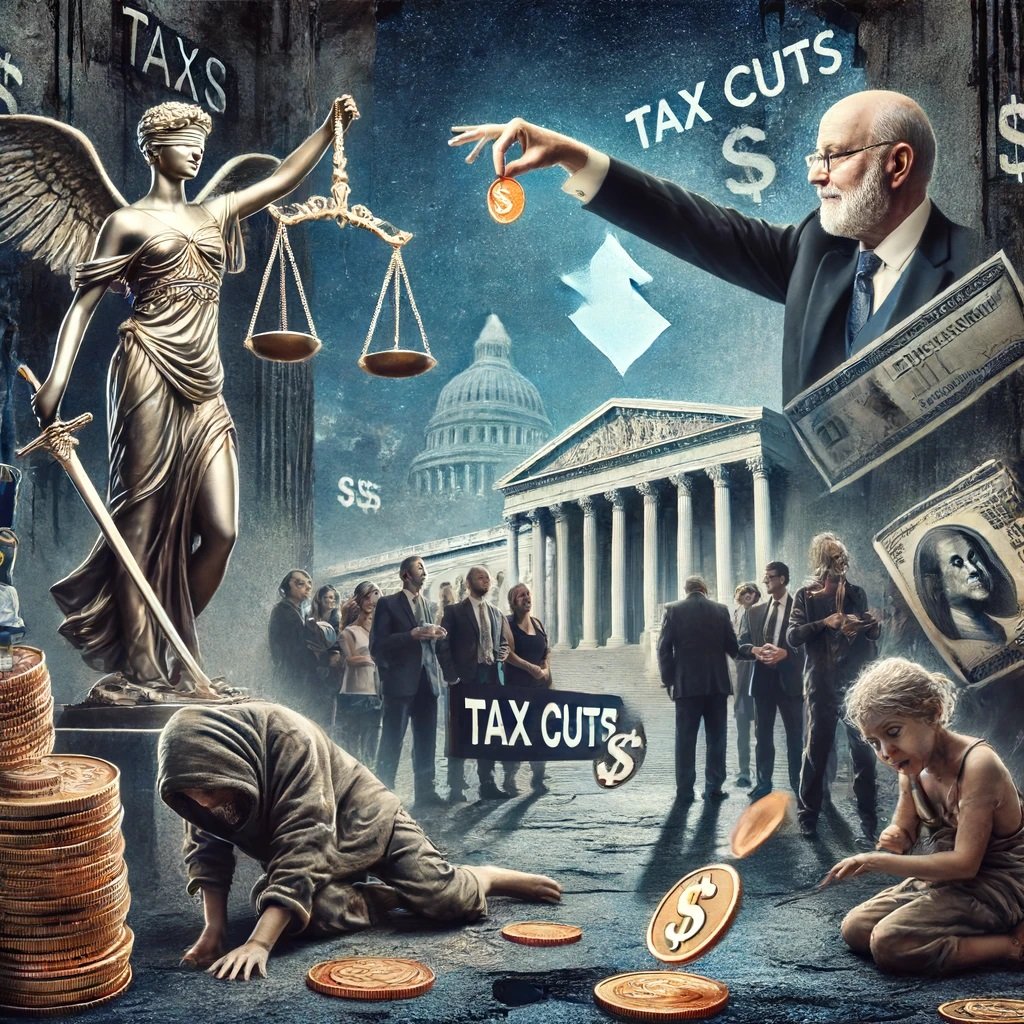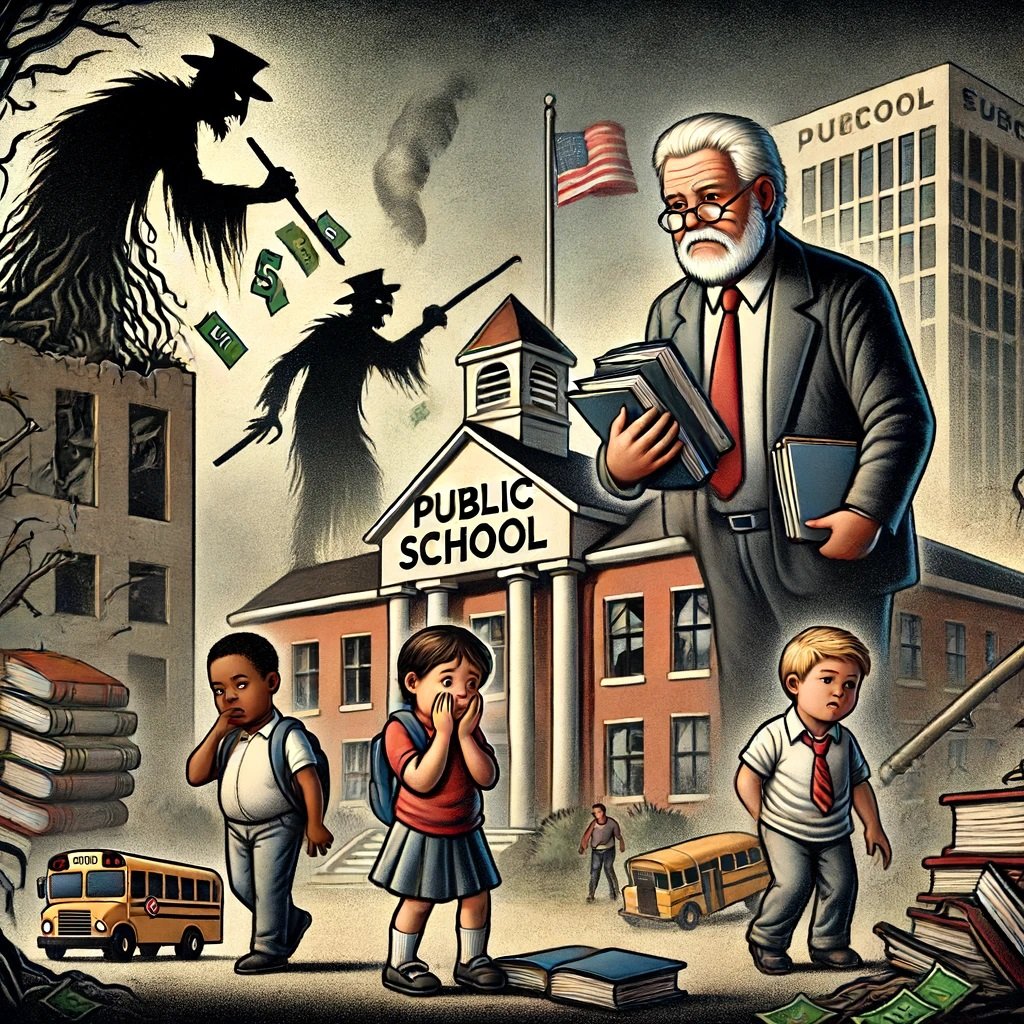Your cart is currently empty!
Project 2025: A Dark Vision for America’s Future


“Our goal is to assemble an army of aligned, vetted, trained, and prepared conservatives to go to work on Day One to deconstruct the Administrative State.”
These words, taken directly from Project 2025’s mission statement, cast a dark shadow over the future of American governance. Like the opening scene of a dystopian novel, they foreshadow a dramatic and potentially devastating shift in how our country is run. This initiative, driven by a coalition of conservative groups, isn’t just about policy changes — it’s about dismantling the very institutions that uphold our democratic society and provide essential services to millions of Americans.
Imagine waking up to a world where the safety nets we rely on — healthcare, social security, environmental protections — are torn apart. Where the structures designed to protect us from corporate greed and political corruption are systematically dismantled. This is not a mere political agenda; it’s a blueprint for a radical transformation that threatens the core of our democracy.
As we delve deeper into the goals and implications of Project 2025, it becomes clear that this isn’t just a policy proposal. It’s a call to arms for those who seek to reshape our nation in a way that could undermine the freedoms and protections we often take for granted. This stark vision for America’s future demands our attention and our action, lest we find ourselves in a reality where the foundational pillars of our society are no longer standing.
Deconstructing the Administrative State
The term “Administrative State” might sound abstract, but it refers to something quite tangible: the network of federal agencies and departments that implement and enforce the laws passed by Congress. These institutions, such as the Environmental Protection Agency (EPA), the Food and Drug Administration (FDA), and the Social Security Administration (SSA), are essential to the functioning of our government. They create regulations, ensure compliance, and provide services that impact our daily lives.
Historically, the administrative state has played a crucial role in shaping modern America. During the Progressive Era and the New Deal, the expansion of federal agencies helped tackle pressing issues like worker safety, environmental conservation, and public health. These agencies brought expertise and continuity to complex areas of governance that elected officials alone could not manage. They have been instrumental in responding to crises, from natural disasters to financial meltdowns, providing stability and protection when it is needed most.
Project 2025’s aim to “deconstruct the Administrative State” threatens to undo this legacy. Stripping away these institutions could lead to chaos, as the regulations and oversight they provide are essential for maintaining order and safety. Without agencies like the EPA, we risk unchecked pollution and environmental degradation. Without the FDA, the safety of our food and medications could be compromised. And without the SSA, millions of Americans could lose the financial support they depend on.
Furthermore, dismantling these agencies opens the door to potential corruption. In the absence of regulatory bodies, industries could operate without accountability, leading to abuses of power and exploitation. The lack of oversight could result in a “wild west” scenario, where corporate interests trump public good, and the average citizen is left vulnerable.
In essence, the deconstruction of the Administrative State is not just a bureaucratic reshuffle; it’s a dismantling of the protective barriers that have been built over decades to safeguard the public. It poses a significant threat to the order, safety, and integrity of American society

Reproductive Rights
“The Plan” casts a shadow over the landscape of reproductive rights, painting a grim picture for the future of women’s health and autonomy. At its core, this initiative seeks to impose severe restrictions on abortion, contraception, and reproductive healthcare, threatening to turn back the clock on decades of progress.
The policies proposed under Project 2025 are nothing short of draconian. They aim to severely limit access to abortion, pushing for bans even in cases where the mother’s health is at risk. Restrictions on contraception are also on the table, with proposals to cut funding for family planning services and limit access to birth control. This assault on reproductive healthcare extends to defunding clinics that provide vital services, leaving many women without essential medical care.
Imagine a world where a young woman, facing an unplanned pregnancy, finds herself without options. The safe, legal avenues to terminate her pregnancy have been closed off, replaced by a murky underground network of unsafe procedures. This is not a dystopian fiction but a potential reality under Project 2025. The tragic consequences of such policies are clear: an increase in unsafe abortions, leading to higher rates of maternal mortality and long-term health complications.
The impact of these policies would be felt most acutely by marginalized communities. Women of color, low-income women, and those living in rural areas would find their already limited access to reproductive healthcare further restricted. These groups, who often face systemic barriers to healthcare, would be disproportionately affected, deepening existing inequalities.
Broader societal implications are equally dire. Limiting reproductive rights undermines women’s autonomy, stripping them of the power to make decisions about their own bodies and futures. This erosion of rights is not just a women’s issue; it affects entire communities. When women cannot control their reproductive lives, their economic stability, educational opportunities, and overall well-being are jeopardized.
The vision of Project 2025, with its restrictive stance on reproductive rights, threatens to create a landscape of fear and uncertainty. It is a vision that disregards the complexities of women’s lives and the importance of their autonomy. The vivid imagery of women being forced into dangerous situations, stripped of their agency, and facing a future of diminished opportunities is a stark reminder of what is at stake.
In this looming reality, the struggle for reproductive rights becomes more urgent than ever. It is a fight not just for individual freedom but for the soul of a society that values equality, health, and the right to choose one’s path.

Welfare Programs: Medicare and Social Security
The Project envisions a future where the safety nets of Medicare and Social Security are radically altered, threatening the well-being of millions of Americans who rely on these programs. These proposed changes could transform the landscape of healthcare and financial security, leaving our most vulnerable populations at risk.
At the heart of Project 2025’s agenda are plans to privatize, cut, or even dismantle Medicare and Social Security. The push for privatization aims to shift these essential services into the hands of private companies, a move that could lead to increased costs and reduced coverage. Cuts to funding are also on the table, potentially slashing the benefits that many seniors and low-income individuals depend on for their daily survival. In the most extreme scenario, there is talk of dismantling these programs altogether, effectively removing the safety net that has protected generations of Americans.
The impact of these changes on senior citizens and low-income individuals would be profound. Medicare provides crucial healthcare coverage for older adults, many of whom have chronic conditions and limited financial resources. Reducing benefits or shifting to a privatized system could make healthcare unaffordable for many seniors, forcing them to forgo necessary treatments or medications. Similarly, Social Security is a lifeline for countless retirees and disabled individuals, providing a stable source of income. Cuts to Social Security benefits would plunge many of these individuals into poverty, stripping them of their financial security in their most vulnerable years.
The long-term effects of such drastic changes would be far-reaching. The immediate consequence would be a sharp increase in poverty rates among seniors and low-income individuals. Without the support of Medicare, healthcare costs would skyrocket, leaving many unable to afford the care they need. This would lead to worsening health outcomes and increased mortality rates. Social inequality would deepen, as the gap between the wealthy and the poor widens even further.
Moreover, dismantling these programs would undermine the social contract that has been a cornerstone of American society for decades. Medicare and Social Security are not just financial mechanisms; they represent a collective commitment to care for our elderly and vulnerable. Eroding these programs would signal a shift away from this commitment, towards a society where individuals are left to fend for themselves, regardless of their circumstances.
In this bleak vision of the future, the loss of Medicare and Social Security would reverberate across generations. Families would bear the burden of care for elderly relatives, stretching already thin resources even further. The dream of a secure retirement would become a distant memory for many, replaced by the harsh reality of financial insecurity and healthcare struggles.
“The project’s” plan for Medicare and Social Security pose a dire threat to the fabric of American life. The potential for increased poverty, soaring healthcare costs, and deepening social inequality highlights the urgent need to defend these vital programs. As we confront this proposed future, we must remember the values of compassion and support that have long underpinned our society and fight to preserve the safety nets that protect us all.

Economic Policies
The economic policies outlined in this initiative present a vision that prioritizes tax cuts for the wealthy and extensive deregulation. While these proposals are framed as measures to stimulate growth and enhance prosperity, the reality could be far more troubling, exacerbating income inequality and undermining economic stability.
Central to these economic plans are significant tax cuts for the wealthy and corporations. The argument is that lowering taxes on the rich will spur investment and job creation. However, historical evidence suggests that such policies primarily benefit the affluent, leading to a concentration of wealth at the top. The promised trickle-down effects often fail to materialize, leaving middle and lower-income families struggling to make ends meet.
Deregulation is another key component of this economic agenda. The proposed rollbacks of regulations span multiple sectors, including finance, environmental protection, and labor. While deregulation is touted as a way to reduce bureaucratic red tape and boost business efficiency, it often removes critical safeguards that protect workers, consumers, and the environment. Without these protections, the risks of corporate misconduct, environmental degradation, and exploitation increase substantially.
The impact of these policies on income inequality is stark. Tax cuts for the wealthy would widen the gap between the rich and the poor, as the benefits of economic growth are disproportionately distributed to those at the top. Deregulation, by reducing oversight and accountability, can lead to practices that further marginalize vulnerable populations, increasing their economic hardships.
Economic stability could also be severely compromised. The short-term gains from tax cuts and deregulation might lead to initial boosts in certain economic indicators, but the long-term consequences are often detrimental. Reduced tax revenue can lead to budget deficits, necessitating cuts in public services and infrastructure investment. This, in turn, can stifle sustainable economic growth and lead to increased national debt.
Moreover, the lack of regulatory oversight can create an environment ripe for financial instability. The deregulation of financial markets, for example, played a significant role in the 2008 financial crisis. A similar approach now could set the stage for another economic downturn, as unchecked speculative activities and risky financial behaviors become more prevalent.
The focus on tax cuts for the wealthy and deregulation could deepen income inequality, erode economic stability, and increase the national debt. It is crucial to critically examine these proposals and consider their long-term impacts on the broader society and economy. As we continue to explore the full scope of this initiative, the picture that emerges is one of profound transformation with far-reaching consequences for all Americans.

Education and Public Services
The vision for public education under this initiative paints a picture of sweeping privatization, radical curriculum changes, and significant funding cuts. These changes could fundamentally alter the landscape of American education, with profound implications for equity and access.
Privatization of public schools is at the forefront of these plans. This shift would see public funds diverted to private and charter schools, potentially leaving traditional public schools underfunded and struggling to survive. The promise of choice and competition may sound appealing, but the reality is often a system where only the well-off benefit, while the most vulnerable students are left behind in increasingly resource-strapped public schools.
Curriculum changes proposed under this initiative aim to reshape what and how students learn. There is a push towards promoting conservative values and downplaying subjects such as science, history, and social studies that do not align with this ideology. Such changes threaten to narrow the educational experience, depriving students of a well-rounded education and critical thinking skills essential for navigating the complexities of the modern world.
Funding cuts are another critical component. Slashing budgets for public schools would exacerbate existing inequities, leading to larger class sizes, fewer resources, and diminished support services. Schools in low-income areas, already struggling with limited resources, would be hit hardest, deepening the divide between wealthy and poor districts.
The impact on public school systems and educational equity would be severe. Privatization and funding cuts would likely result in a two-tiered education system where only those with means can access high-quality education. The public schools that serve the majority of students would face declining standards, widening the achievement gap and entrenching social inequalities.
Broader implications for society are equally concerning. Access to quality education is a cornerstone of a thriving democracy and a robust economy. Undermining public education harms workforce readiness, as students graduate without the skills needed to compete in the job market. This could lead to higher unemployment rates, lower economic productivity, and increased social unrest.
A well-educated populace is essential for innovation, economic growth, and civic engagement. The proposed changes to public education threaten to erode these foundations, leaving a generation unprepared for the challenges of the future. The ramifications of Project 2025 are becoming increasingly clear. There will be far-reaching consequences for all aspects of American life.

Conclusion
The vision presented by this initiative is one of profound transformation, touching every aspect of American life. From dismantling the administrative state and restricting reproductive rights to undermining welfare programs, imposing economic policies that favor the wealthy, and gutting public education, the proposed changes would fundamentally alter the fabric of our society.
The impacts are stark and far-reaching: chaos and corruption from a dismantled administrative state, increased maternal mortality and reduced autonomy for women, heightened poverty and inequality as safety nets are cut, economic instability and greater debt, and an education system that fails the most vulnerable. These policies threaten to deepen social divides, undermine democratic institutions, and leave many Americans struggling to survive.
It’s crucial to understand that this is just the beginning. We’ve only scratched the surface of the full scope of this agenda. The implications for environmental policies, healthcare, labor rights, and beyond are equally troubling and deserve thorough examination.
As citizens, it’s our responsibility to stay informed and engaged. The vision for America outlined in this initiative demands our attention and action. I urge you to delve deeper into the details, understand the stakes, and consider the broader consequences. Research extensively, engage in discussions, and advocate for policies that protect the foundational principles of equity, justice, and democracy.
The future of our country depends on our vigilance and willingness to fight for the values that have long underpinned our society. Let us not stand idly by as these pillars are threatened. Our collective action and informed voices can make a difference.
Donate to Joe Biden’s 2024 Campaign
Joe Biden’s Official Campaign Website: You can donate directly to Joe Biden and Kamala Harris’s reelection campaign. This site also provides various donation options and information about the campaign’s goals and achievements. Donate to Biden.
Learn More About Project 2025
Project 2025 Official Website: For detailed information on their policy proposals and goals. Project 2025.